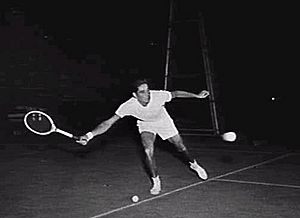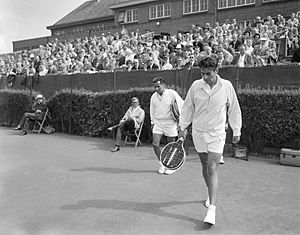Pancho Gonzales facts for kids

Gonzales practicing in Australia in 1954
|
|
| Full name | Ricardo Alonso González |
|---|---|
| Country (sports) | |
| Born | May 9, 1928 Los Angeles, California, U.S. |
| Died | July 3, 1995 (aged 67) Las Vegas, Nevada, U.S. |
| Height | 1.88 m (6 ft 2 in) |
| Turned pro | 1949 |
| Retired | 1974 |
| Plays | Right-handed (one-handed backhand) |
| Int. Tennis HoF | 1968 (member page) |
| Singles | |
| Career record | 1250–561 (69.05%) |
| Career titles | 111 |
| Highest ranking | No. 1 (1952, Joe McCauley) |
| Grand Slam singles results | |
| Australian Open | 3R (1969) |
| French Open | SF (1949, 1968) |
| Wimbledon | 4R (1949, 1969) |
| US Open | W (1948, 1949) |
| Other tournaments | |
| Professional majors | |
| US Pro | W (1953, 1954, 1955, 1956, 1957, 1958, 1959, 1961) |
| Wembley Pro | W (1950, 1951, 1952, 1956) |
| French Pro | F (1956, 1961) |
| TOC | W (1957 Forest Hills, 1958 Forest Hills, 1959 Sydney) |
| Doubles | |
| Grand Slam doubles results | |
| French Open | W (1949) |
| Wimbledon | W (1949) |
| Grand Slam mixed doubles results | |
| Wimbledon | QF (1968) |
Ricardo Alonso González (born May 9, 1928 – died July 3, 1995), known as Pancho Gonzales, was an American tennis player. Many experts consider him one of the greatest tennis players ever. He won 14 major singles titles during his career. He was the top professional player in the 1950s. Pancho Gonzales holds the record for being ranked the world No. 1 for eight years.
Gonzales was a very determined player with a strong will to win. He was known for his powerful serves and amazing net play. Many other players found him intimidating. However, fans loved watching him play, and he attracted huge crowds. After he passed away, a Sports Illustrated article said that if the world depended on a tennis match, Pancho Gonzales was the player you would want to serve.
Pancho Gonzales: A Tennis Legend
Early Life and Amateur Career
Pancho Gonzales got his first tennis racquet from his mother when he was 12 years old. He mostly taught himself to play by watching others at Exposition Park in Los Angeles. Once he found tennis, he became very focused on the sport.
A man named Frank Poulain, who owned the tennis shop at Exposition Park, helped him. Pancho sometimes even slept at the shop. Because he often missed school, some people in the tennis world didn't support him at first. The head of tennis in Southern California, Perry T. Jones, even banned him from playing in tournaments for a while.
After serving in the Navy for two years, Gonzales returned to tennis. By age 19, he was tall and athletic, standing about 6 feet 3 inches (1.91 m) (1.88 m). His height gave him an advantage over many rivals. Tennis experts described him as an incredible athlete with quick reflexes. One said watching him was like seeing "a god patrolling his personal heaven."
In 1947, Pancho became a nationally ranked player. He surprised many by reaching the semifinals of the Pacific Southwest Championships. The next year, Perry T. Jones allowed him to play in major tournaments. Gonzales, seeded No. 8, won the United States Championships easily. He beat Eric Sturgess in the finals with his strong serve-and-volley style. This win made him the top-ranked American player that year.
In 1949, Gonzales won the United States Championships again. This time, he beat Ted Schroeder in a thrilling five-set match. This victory proved he was the best amateur player in the world. He also won both his matches in the Davis Cup finals.
Turning Professional
After his amateur success, Gonzales became a professional tennis player in 1949. In his first year as a pro, he played against Jack Kramer, who was the top professional player at the time. Kramer beat Gonzales in most of their matches. This tough experience changed Gonzales, making him the determined and sometimes difficult player he became known as.

Kramer noted that Gonzales learned a lot from these losses. He realized he had to win to keep his career going. This made him even more focused on improving his game.
Rising to the Top Professional Player
From 1951 to 1953, Gonzales played less often but continued to improve. He even bought a tennis shop. Despite not playing as much, he started winning most of his matches again. He beat Jack Kramer in many of their later matches.
In 1952, Gonzales became one of the top professional players. He won four out of five tournaments he entered, beating both Pancho Segura and Jack Kramer. Even though some rankings placed Segura higher, many believed Gonzales was the true world No. 1 professional player that year.
In 1954, Gonzales truly established himself as the world's best. He won the U.S. Pro tournament and dominated tours in Australia. He beat top players like Frank Sedgman and Ken McGregor.
Years of Dominance
For the next seven years, Pancho Gonzales was the most dominant player in men's tennis. He regularly defeated other tennis greats like Tony Trabert, Ken Rosewall, Lew Hoad, and Rod Laver. Trabert, who played many matches against Gonzales, said that Gonzales's serve was incredibly powerful and won him many easy points.
Gonzales won the U.S. Pro Tennis Championships eight times and the Wembley Championship four times. He also won the Tournament of Champions three times. He beat every Wimbledon champion who turned professional for ten years in a row. His game was so strong that rules were even briefly changed to stop him from rushing the net after serving. But Gonzales still won, and the rules were changed back.
Gonzales was known for his incredible ability to play his best in tough situations, especially in the fifth set of long matches.
Key Rivalries
Gonzales had strong rivalries with many players. He often felt he was paid less than the players he was beating, which fueled his competitive fire. He was often a loner on tour, focusing only on his matches.
- Tony Trabert: In 1956, Gonzales beat Trabert 74 matches to 27. Trabert respected Gonzales's tennis skills but found him difficult off the court.
- Ken Rosewall: In 1957, Gonzales played a long series against Rosewall. Despite a hand injury, Gonzales won their Australian tour 7 matches to 3. He went on to beat Rosewall 50 matches to 26 overall.
- Lew Hoad: In 1958, Hoad, a powerful young Australian, challenged Gonzales. Hoad won many early matches, but Gonzales improved his backhand and ended up winning their series 51 to 36.
- Rod Laver: Jack Kramer believed Gonzales could have beaten Laver regularly, even though Laver was dominant in the late 1960s. In 1970, when Gonzales was 41 and Laver was considered the world No. 1, Gonzales beat Laver in a famous five-set match in New York.
Open Tennis Era
Most of Gonzales's career happened before the Open Era began in 1968. This meant he couldn't play in Grand Slam tournaments for 18 years after turning pro. Many believe he would have won many more Grand Slam titles if he had been allowed to compete.
In May 1968, at 40 years old, Gonzales played in the first major open tournament, the French Open. Even on slow clay courts, which weren't his favorite, he beat the defending champion Roy Emerson in the quarterfinals. He then lost to Rod Laver in the semifinals.
One of the Greatest Matches Ever Played
In 1969, at Wimbledon, 41-year-old Gonzales played a historic match against Charlie Pasarell, who was 16 years younger. Pasarell won the first set 24–22. As daylight faded, Gonzales wanted to stop, but the referee said no. Gonzales then lost the second set quickly.
The next day, Gonzales came back with incredible power. He won three straight sets: 16–14, 6–3, 11–9. In the final set, Gonzales saved seven match points against him, showing amazing determination. He won the match after 5 hours and 12 minutes. The final score was 22–24, 1–6, 16–14, 6–3, 11–9. This match is still remembered as one of the greatest in tennis history. It also led to the introduction of the tie-break rule to prevent such long matches.
Later Professional Years
Gonzales continued to play in tournaments into his 40s. He often beat younger, top-ranked players. In 1969, he won the Howard Hughes Open and the Pacific Southwest Open. He beat players like John Newcombe and Ken Rosewall. He was the top American money-winner that year.
In 1972, at almost 44 years old, Gonzales became the oldest player to win a professional tournament, the Des Moines Open. He even beat 19-year-old Jimmy Connors in 1971 by playing from the baseline, which was not his usual style.
Gonzales was honored for his achievements by being inducted into the International Tennis Hall of Fame in 1968. In 2013, California State University, Los Angeles named their Tennis Center the Rosie Casals/Pancho Gonzalez Tennis Center.
Personal Life
Pancho Gonzales's parents, Manuel Antonio González and Carmen Alire Alonso, came from Mexico to the U.S. in the early 1900s. Pancho was the oldest of seven children. His family was working-class, and he described his childhood as having "few luxuries" but always enough food.
After his tennis career, Gonzales sometimes worked as a television commentator for ABC. He was known for his honest and direct comments about other players.
Gonzales passed away on July 3, 1995, at the age of 67, after battling stomach cancer.
Pancho Gonzales's Place Among Tennis Greats
Many people in the tennis world consider Pancho Gonzales to be one of the greatest male players in history. He was ranked the World No. 1 for eight years, possibly seven of them in a row (1954-1960). This is a record for male tennis players.
Pancho Segura, who played against many top players from different eras, believed Gonzales was the best player of all time. Other tennis legends like Lew Hoad and Allen Fox agreed.
Tennis historian Bud Collins has written that Gonzales was "probably as good as anyone who ever played the game, if not better." In 2005, several great Australian players who competed against Gonzales were asked who the best player they ever faced was.
- Mal Anderson named Gonzales, saying he was "very difficult" and could "exploit your weaknesses fast."
- Ashley Cooper also named Gonzales, saying he never beat him on tour.
- Frank Sedgman called Gonzales the "second best" after Jack Kramer, describing him as "a great competitor — a great athlete."
Gonzales's long career and ability to beat top players across different generations show his incredible talent and lasting impact on tennis.
See also
 In Spanish: Pancho Gonzales para niños
In Spanish: Pancho Gonzales para niños

